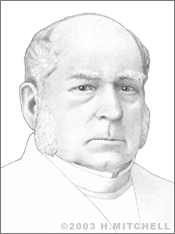Henry Bessemer
“Man of Steel” Henry Bessemer was born on January 19, 1813 in Charlton, Hertfordshire, England. The first to develop a process for mass-producing steel inexpensively, this son of an engineer was a prolific and diverse inventor throughout his life. At age 17, he came up with the idea of creating embossed stamps to use on title deeds. Then he realized a better idea was just to print new dates on stamps rather than use new ones. Implementing this practice saved the Stamp Service a great deal of money. Bessemer was not compensated for these ideas.
Bessemer, who was mostly self-educated, made his first fortune with an idea for using brass as a paint additive to produce a bronze-colored powder that could be used for décor in place of gold. He invented machines to mix the substance automatically and set up a factory that he kept top-secret so his process would not be discovered. He and his brothers-in-law ran it and were extremely successful.
In 1854, while the Crimean War was under way, Bessemer created a new type of artillery shell. His shells were heavier than the typically used cannon balls and would be cut with spiral grooves that would give them spin and keep them on target. Bessemer had presented his shell idea to the War Department, but they had been disinterested. When Napoleon himself expressed interest during a dinner with Bessemer in Paris, he was encouraged, but first he needed to come up with a way to mass produce structural steel that he could use to create sturdier gun barrels to support these heavy shells. This would set him on a path to perhaps the greatest accomplishment of his life: the Bessemer Converter.

The Bessemer Converter could make 30 tons of high-grade steel in half an hour. Its evolution began with Bessemer’s attempt to blow air in through a vat of molten iron. He found that the line along which the air blew produced a type of material that had a higher melting point than the rest of the substance. This was because the air removed some of the carbon in the material. Repeating the decarbonization process over and over would eventually refine the substance into very strong steel. It should be noted that an American named William Kelly had held a patent for "a system of air blowing the carbon out of pig iron," but bankruptcy forced him to sell his patent to Bessemer. In 1856, Bessemer patented his refinery process and created huge furnaces that could handle it.
Shortly after introducing the Bessemer Converter, Bessemer established Henry Bessemer & Co. to manufacture steel and was able to undersell nearly all competitors. This inspired a flood of applications to license the technology. As a result, he became a very wealthy man. Even now, modern steel is made using technology based on Bessemer's process. It was essential to the development of skyscrapers, to the railroad and construction business, and to the defense industry.
In 1860, Bessemer patented the tilting convertor, which produced steel more efficiently than the earlier fixed furnace. During his years as an inventor, Bessemer also created a method for embossing velvet, a hydraulic machine for extracting juice from sugar cane, steam-driven fans for ventilating mines, and a furnace designed especially for making sheet glass. But not all his ideas were successful. In 1869, he began working on a seasickness-proof sailing ship, based on an idea he had to mount the ship’s interior cabin on top of a gyroscope. In theory, this would keep the cabin horizontal at all times. He did not take the advice of critics who said it would never work. Instead he forged ahead and made the vessel, dubbed the Bessemer Saloon Ship, a reality. However, it was too unstable to steer and crashed into a pier on its maiden voyage in 1875. The ship never sailed again.
Over the course of his lifetime, Bessemer earned a total of 110 patents. In 1879, he was knighted for his contributions to the scientific world, and that year, he was also granted Fellowship in the Royal Society. He died on March 14, 1898 in London.


